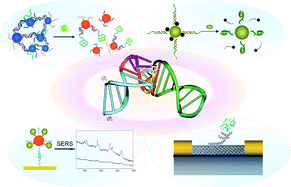This review summarizes recent progress in the development of biosensors by integrating functional DNA molecules with different types of nanomaterials, including metallic nanoparticles, semiconductor nanoparticles, magnetic nanoparticles, and carbon nanotubes. On one hand, advances in nanoscale science and technology have generated nanomaterials with unique optical, electrical, magnetic and catalytic properties. On the other hand, recent progress in biology has resulted in functional DNAs, a new class of DNAs that can either bind to a target molecule (known as aptamers) or perform catalytic reactions (known as DNAzymes) with the ability to recognize a broad range of targets from metal ions to organic molecules, proteins and cells specifically. By taking advantage of the strengths in both fields, the physical and chemical properties of nanomaterials have been modulated by the target recognition and catalytic activity of functional DNAs in the presence of a target analyte, resulting in a large number of colorimetric, fluorescent, electrochemical, surface-enhanced Raman scattering and magnetic resonance imaging sensors for the detection of a broad range of analytes with high sensitivity and selectivity.

You have access to this article
 Please wait while we load your content...
Something went wrong. Try again?
Please wait while we load your content...
Something went wrong. Try again?


 Please wait while we load your content...
Please wait while we load your content...